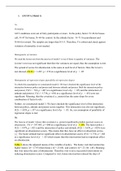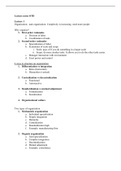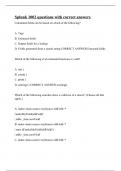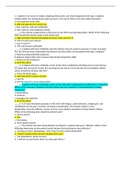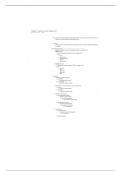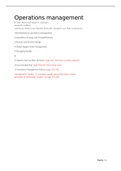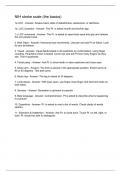1. ANCOVA (Model 1)
1a.
Normality
All 5 conditions exist out of forty participants or more. In the policy factor: N=46 for house-
call, N=47 for bonus, N=44 for control. In the attitude factor: N=71 for punishment and
N=66 for reward. The samples are larger than N>15. Therefore, F is robust and check against
violation of normality is not needed.
Homogeneity of variance
We used the levens test from the ancova of model 1 to see if there is equality of variances. The
Levene’s test was not significant therefore the variances are equal, thus the assumption is met.
The spread of scores for absenteeism is the same at each level of factors. Here the Leven’s
test showed, F(131) = 1.287, p =.274 at a significance level of p > .05
Homogeneity of regression slopes (parallelity of regression slopes)
To check this assumption we constructed model 2. We have checked the significance level of the
interaction between policy and pretest and between attitude and pretest. Both the interaction policy
and pretest ( F(2) = .724, p =.487 at a significance level of p > .05) and the interaction of
attitude and pretest ( F(1) = 3.730, p =.056 at a significance level of p > .05) were not
significant. Meaning, that the covariate (i.e., pretest) has the same slope for every
combination of factor levels.
Further, we constructed model 3. We have checked the significance level of the interaction
between policy, attitude and pretest scores together. This interaction was also not significant ,
F(2) = 1,039, p =.357 at a significance level of p > .05. So, our assumption of parallelity of
regression slopes is met.
1b.
The Ancova of model 1 shows that covariate (i.e., pretest) significantly predicts post-test scores on
absenteeism. F(1) = 107.483, p =.000 at a significance level of p > .05). The factor policy (
F(2) = 3.978, p =.021) and the interaction of policy and attitude (F(2) = 3.639, p =.029) were
significant on absenteeism scores. This means that they have an effect on absentism scores,
[..] The factor attitude had no significant effect on absenteeism socres (F(1) =1.750, p =.188
at a significance level of p > .05 which means that this intervention had no important effect
on absenteeism.
Table 1 shows the adjusted means of the variable of policy. The home visit intervention has
higher mean ( M = 27.93) than bonus ( M = 23.68) and control ( M = 23.10) ( M ) Meaning
that visit raises the days of absenteeism. Therefore visit is not a successful intervention on
reducing absenteeism scores. Compared to visit, bonus intervention reduced the days of
, absenteeism but compared to control condition the adjusted means are similar. This means,
that having no policy intervention might have the same results on reducing absenteeism as
giving employees a bonus.
For attitude, negative attitude ( M = 25.89) raised the days of absenteeism in participants
compared to positive attitude ( M = 23.91). But as shown above , the attitude of the super has
no significant effect on absenteeism scores.
1c.
Table 3
In previous assignment we have found that attitude ( F(1) = 1.704, p =.194 and policy (F(2) =
.161, p =.851) had no significant effect on absenteeism scores. But model 1 shows that for
policy (F(2) = 3 .978, p =.021 and for the interaction between policy and attitude (F(2) =
3.639, p =.029 is significant. This happened because we added the covariate, so by controlling
the influence of pretest the impact of both interventions have changed. This means that only
when you take into account the pretest scores the policy and the interaction between policy
and attitude have a significant effect.
The differences found between the first analysis (Anova) and the second analysis (Ancova)
are due to both the reduction of error and the reduction of bias. In model 1 we reduced the
error variance because Ancova explains more of the unexplained variances (SSr =
18125.195) compared to the Anova of the first assignment (Ssr = 9921.882). This happened
because in the ANCOVA we added the covariate of pre-test scores. This allowed us to asses
more accurately the effect of the independent variable.
Because we did not include the covariate of pretest in our first Anova, the F-values we found
were biased. In model 1 the confounding variable has been identified therefore we were able
to reduce the bias. We added the covariate of pretest which was found to have a significant
effect on absenteeism scores.
2
a) Maybe table test of within subjects effect TIME and means
We have done an anova analysis but now pretest was not a covariate. We created a new
within factor (Time) with two levels (pretest and posttest). The between subject factors were
policy and attitude. For absenteeism the effect of time ( F(1) = 16.736, p =.000, the
interaction of time and policy F(2) = 5.884, p =.004 and the interaction of time, attitude and
policy F(2) = 3.719, p =.027 were significant. However the interaction of time with attitude
was not significant F(1) = 1.356, p =.246 even when the covariate was added.
TABLE WHATEVER shows the adjusted means of the variable of policy. The bonus
intervention has a higher adjusted mean ( M = 27.39) than homevisit ( M = 25.24) and control
( M = 26.76). Meaning that getting a bonus might increase the days of absenteeism. There are
not many differences between the means but when the supervisor visiots the employeers at
1a.
Normality
All 5 conditions exist out of forty participants or more. In the policy factor: N=46 for house-
call, N=47 for bonus, N=44 for control. In the attitude factor: N=71 for punishment and
N=66 for reward. The samples are larger than N>15. Therefore, F is robust and check against
violation of normality is not needed.
Homogeneity of variance
We used the levens test from the ancova of model 1 to see if there is equality of variances. The
Levene’s test was not significant therefore the variances are equal, thus the assumption is met.
The spread of scores for absenteeism is the same at each level of factors. Here the Leven’s
test showed, F(131) = 1.287, p =.274 at a significance level of p > .05
Homogeneity of regression slopes (parallelity of regression slopes)
To check this assumption we constructed model 2. We have checked the significance level of the
interaction between policy and pretest and between attitude and pretest. Both the interaction policy
and pretest ( F(2) = .724, p =.487 at a significance level of p > .05) and the interaction of
attitude and pretest ( F(1) = 3.730, p =.056 at a significance level of p > .05) were not
significant. Meaning, that the covariate (i.e., pretest) has the same slope for every
combination of factor levels.
Further, we constructed model 3. We have checked the significance level of the interaction
between policy, attitude and pretest scores together. This interaction was also not significant ,
F(2) = 1,039, p =.357 at a significance level of p > .05. So, our assumption of parallelity of
regression slopes is met.
1b.
The Ancova of model 1 shows that covariate (i.e., pretest) significantly predicts post-test scores on
absenteeism. F(1) = 107.483, p =.000 at a significance level of p > .05). The factor policy (
F(2) = 3.978, p =.021) and the interaction of policy and attitude (F(2) = 3.639, p =.029) were
significant on absenteeism scores. This means that they have an effect on absentism scores,
[..] The factor attitude had no significant effect on absenteeism socres (F(1) =1.750, p =.188
at a significance level of p > .05 which means that this intervention had no important effect
on absenteeism.
Table 1 shows the adjusted means of the variable of policy. The home visit intervention has
higher mean ( M = 27.93) than bonus ( M = 23.68) and control ( M = 23.10) ( M ) Meaning
that visit raises the days of absenteeism. Therefore visit is not a successful intervention on
reducing absenteeism scores. Compared to visit, bonus intervention reduced the days of
, absenteeism but compared to control condition the adjusted means are similar. This means,
that having no policy intervention might have the same results on reducing absenteeism as
giving employees a bonus.
For attitude, negative attitude ( M = 25.89) raised the days of absenteeism in participants
compared to positive attitude ( M = 23.91). But as shown above , the attitude of the super has
no significant effect on absenteeism scores.
1c.
Table 3
In previous assignment we have found that attitude ( F(1) = 1.704, p =.194 and policy (F(2) =
.161, p =.851) had no significant effect on absenteeism scores. But model 1 shows that for
policy (F(2) = 3 .978, p =.021 and for the interaction between policy and attitude (F(2) =
3.639, p =.029 is significant. This happened because we added the covariate, so by controlling
the influence of pretest the impact of both interventions have changed. This means that only
when you take into account the pretest scores the policy and the interaction between policy
and attitude have a significant effect.
The differences found between the first analysis (Anova) and the second analysis (Ancova)
are due to both the reduction of error and the reduction of bias. In model 1 we reduced the
error variance because Ancova explains more of the unexplained variances (SSr =
18125.195) compared to the Anova of the first assignment (Ssr = 9921.882). This happened
because in the ANCOVA we added the covariate of pre-test scores. This allowed us to asses
more accurately the effect of the independent variable.
Because we did not include the covariate of pretest in our first Anova, the F-values we found
were biased. In model 1 the confounding variable has been identified therefore we were able
to reduce the bias. We added the covariate of pretest which was found to have a significant
effect on absenteeism scores.
2
a) Maybe table test of within subjects effect TIME and means
We have done an anova analysis but now pretest was not a covariate. We created a new
within factor (Time) with two levels (pretest and posttest). The between subject factors were
policy and attitude. For absenteeism the effect of time ( F(1) = 16.736, p =.000, the
interaction of time and policy F(2) = 5.884, p =.004 and the interaction of time, attitude and
policy F(2) = 3.719, p =.027 were significant. However the interaction of time with attitude
was not significant F(1) = 1.356, p =.246 even when the covariate was added.
TABLE WHATEVER shows the adjusted means of the variable of policy. The bonus
intervention has a higher adjusted mean ( M = 27.39) than homevisit ( M = 25.24) and control
( M = 26.76). Meaning that getting a bonus might increase the days of absenteeism. There are
not many differences between the means but when the supervisor visiots the employeers at

